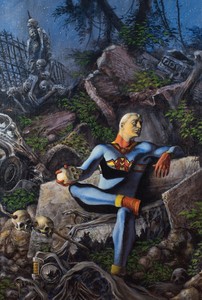
Miracleman is a British Golden Age comic book superhero appearing in comic books first published by L. Miller & Son, Ltd. Created by Mick Anglo, the character first appeared in Marvelman #25. The character was subsequently revived in 1982 by Alan Moore and Garry Leach as the lead of Marvelman in the pages of Warrior. After that publication was cancelled the revival was continued as Miracleman by Eclipse Comics in 1985, with the character renamed accordingly, but went out of print following the company's demise in 1994.
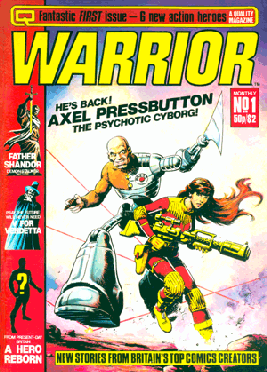
Warrior was a British comics anthology that ran for 26 issues between March 1982 and January 1985. It was edited by Dez Skinn and published by his company Quality Communications. It featured early work by numerous figures who would go on to successful careers in the industry, including Alan Moore, Alan Davis, David Lloyd, Steve Dillon, and Grant Morrison; it also included contributions by the likes of Brian Bolland and John Bolton, while many of the magazine's painted covers were by Mick Austin.
Derek "Dez" Skinn is a British comic and magazine editor, and author of a number of books on comics. As head of Marvel Comics' operations in England in the late 1970s, Skinn reformatted existing titles, launched new ones, and acquired the BBC license for Doctor Who Weekly. After leaving Marvel UK, Skinn founded and edited Warrior, which featured key works by Alan Moore.
Michael Anglo was a British comic book writer, editor and artist, as well as an author. He is best known for creating the superhero Marvelman, later known as Miracleman.

Jaspers' Warp, sometimes referred to as Crooked World is a superhero comic book storyline from the British Captain Britain strip printed across several Marvel UK titles between 1981 and 1984.

L. Miller & Son, Ltd. was a British publisher of magazines, comic books, and pulp fiction intended primarily to take advantage of the British ban on importing printed matter. Between 1943 and 1966, the firm published British editions of many American comic books, primarily those of Fawcett Comics. The company is best known for the 1954 creation of Marvelman – a blatant imitation of the Golden Age Captain Marvel – after America's Fawcett Publications capitulated to National Periodicals. L. Miller & Son also published a large line of Western comics — many reprints but also some original titles.
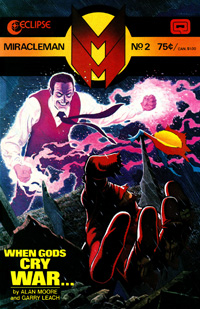
Kid Miracleman is a fictional British Golden Age comic book superhero, originally created by Mick Anglo for publisher L. Miller & Son in 1955, and debuting in Marvelman #102, dated July 10 of that year.

Young Marvelman was a British Golden Age superhero comic book, published by L. Miller & Son in the United Kingdom between 1954 and 1963. The lead character was originally created in 1954 by Mick Anglo as a replacement for Captain Marvel Jr due to Fawcett Publications ending the latter's titles following legal action by DC Comics.

Superhero fiction is a genre of speculative fiction examining the adventures, personalities and ethics of costumed crime fighters known as superheroes, who often possess superhuman powers and battle similarly powered criminals known as supervillains. The genre primarily falls between hard fantasy and soft science fiction spectrum of scientific realism. It is most commonly associated with American comic books, though it has expanded into other media through adaptations and original works.
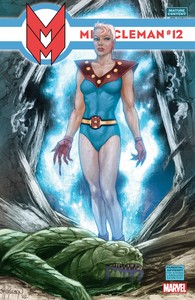
Miraclewoman is a fictional comic book superhero originally created by Alan Moore for publisher Eclipse Comics in 1986, and debuting in Miracleman #10, dated December of that year.

Miracleman is a superhero comic book series, centred on the character of the same name. Originally created by Mick Anglo and published by L. Miller & Son, Ltd. as Marvelman between 1954 and 1963, the character was revived in 1982 for a revisionist story written by Alan Moore, beginning in the pages of British anthology Warrior. From 1985 the character was renamed Miracleman, and the series was continued by American publisher Eclipse Comics until 1993. Since 2009 the rights to the character have been licensed by Marvel Comics, who have published new material.
Marvel is both a surname and a given name. Notable people and characters with the name include:

Young Miracleman is a fictional British Golden Age comic book superhero, originally created by Mick Anglo for publisher L. Miller & Son in 1954, and debuting in Young Marvelman #25, dated 3 February of that year as a replacement for Fawcett Publications' Captain Marvel Jr.. A comic based on his adventures ran for 345 issues until 1963.
Arnold Book Company (ABC) was a British publisher of comic books that operated in the late 1940s and 1950s, most actively from 1950 to 1954. ABC published original titles like the war comic Ace Malloy of the Special Squadron and the science fiction title Space Comics, and reprints of American horror and crime titles like Adventures into the Unknown, Black Magic Comics, and Justice Traps the Guilty. British contributors to the company's titles include Mick Anglo and Denis Gifford. Arnold Book Company was closely connected to the fellow British comics publisher L. Miller & Son.

Marvelman was a British Golden Age superhero comic book, published by L. Miller & Son in the United Kingdom between 1954 and 1963. The lead character was originally created by Mick Anglo as a replacement for Captain Marvel due to Fawcett Publications ending the latter's titles following legal action by DC Comics.
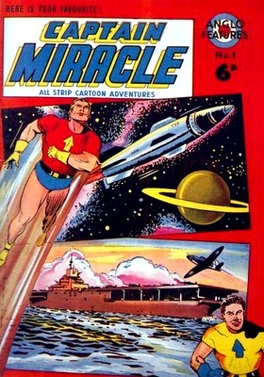
Captain Miracle is a fictional British Silver Age comic book superhero. The character was originally created by Mick Anglo for his own Anglo Features imprint, using material planned for Marvelman - itself a reworking of Fawcett Publications' Captain Marvel. The character first appeared in Captain Miracle #1, published in October 1960.

Marvelman Family was a British Silver Age superhero comic book, featuring eponymous team consisting of the characters Marvelman, Young Marvelman and Kid Marvelman. The title was created in 1956 by Mick Anglo for publisher L. Miller & Son as a companion title for the company's Marvelman and Young Marvelman magazines.
The comic book character Marvelman has been the subject of several legal issues, even after being renamed as Miracleman in 1985. The character and its derivatives were created by Mick Anglo in 1954 at the request of publisher Len Miller. The copyright was retained by Anglo ever since. However a series of misconceptions and misunderstandings meant that, following the character's revival in 1982 and the collapse of publisher Eclipse Comics in 1994 the series spent 15 years out of print while various parties who believed they had portions of the rights attempted to claim ownership, a belief that greatly informed coverage of Miracleman during the interregnum. This was resolved by the confirmation of Anglo's ownership in 2009.
Captain Britain is a British comic feature published by Marvel UK - the British division of Marvel Comics between 1976 and 1985, in various anthology magazines.
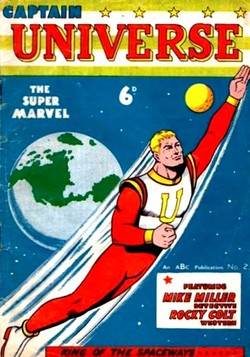
Captain Universe is a fictional British superhero who appeared in comic books published by Arnold Book Company in 1954. The character was created by Mick Anglo; like his other creations of the era Captain Universe was heavily influenced by Fawcett Publications' Captain Marvel.














